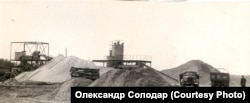ORBITA, Ukraine -- The apocalyptic photographs of the abandoned town of Pripyat and its rusting amusement park, abandoned schools, and reforested streets have become the icons of the April 1986 Chernobyl nuclear disaster.
But Pripyat was not the only Soviet city to see its fate radically altered as a result of those horrific events. Of the 11 nuclear power plants under construction in the Soviet Union when Chernobyl happened, only one was completed.
The others, such as the Chigirinsky nuclear power plant and its satellite town of Orbita in central Ukraine, are today nearly ghost towns with the same haunted, haunting visage as Chernobyl itself.
In 1970, the Soviet government decided to build a hydroelectric facility on the shores of the Kremenshuk Reservoir in central Ukraine's Cherkaska Oblast. By the early 1980s, the authorities were more ambitious and decided to change the plan and instead build the Chigirinsky nuclear power plant.
Together with the plant, the government began construction on the city of Orbita, which was projected to become home to some 20,000 people. By 1980, Orbita boasted two occupied residential buildings, an administrative center, a cafeteria, a club, and a department store.
"In Soviet times, things were good here," recalls Hryhoriy Chaplinskiy, who came to the town in 1977 to work as an electrician at the plant. "Those nine-story buildings were dormitories for workers and people were living there. Later, they shut off the gas and the water and everyone moved out."
Amid doubts about the safety of Chernobyl-style reactors, work on Chigirinsky was frozen in 1983. At the time, there were more than 5,000 people -- moved in from throughout the Soviet Union -- building the facility. Although there was nothing for them to do at Chigirinsky, the authorities decided not to relocate them again. They were given makeshift work in Cherkasy, some 25 kilometers away, and bused back and forth each day.
In the wake of the 1986 Chernobyl disaster, the Chigirinsky project was canceled in 1989. The plant workers were left with no employment and quickly began moving away.
Now there are about 90 people living in Orbita, including six children who are bused to school in the neighboring town of Vitove.
A few old cars rattle through the streets, but most of Orbita's denizens seem to prefer bicycles. You can occasionally see contemporary graffiti and fresh litter. The insides of some of the shuttered buildings are spotted with traces of recent paintball battles.
Two residential buildings have gas, water, and electricity. There are even satellite dishes bringing in television and the Internet. Someone has turned a ground-floor apartment into a small store that is open two hours each morning and two more after lunch.
People either work in neighboring towns or eke out a living searching the ruins of Orbita for remaining scrap metal or anything else that can be sold.
It is not an attractive place to live.
"We had some displaced people from Volnovakha," one local told Current Time, a project led by RFE/RL in cooperation with VOA, referring to a town in Ukraine's war-torn eastern region of Donetsk. "They came in 2014. But when things calmed down over there, they went back."








